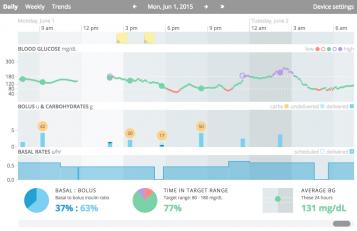For people with Type 1 diabetes, every meal is a math exercise: How many carbs per ounce, how many ounces, how much physical activity, how much insulin to take now? It would be great to recall the dose and response in a similar situation, but memory is unreliable. Even more farfetched is the idea of a caregiver or health provider having access to that kind of detailed knowledge.
This is just the type of problem that UCSF’s Center for Digital Health Innovation (CDHI) loves to help tackle. Rhona Snyman, CDHI’s operations director, describes it as solving problems using technology translation. “We partner with faculty, startups and Industry to ensure that clinically useful technology is effectively incorporated into patient care,” she says.

Tidepool, a non-profit organization developing a suite of apps for Type 1 diabetes patients, was one of CHDI’s inaugural partners. Tidepool collaborated with UCSF clinicians, who brought their expertise in diabetes care to the functionality of the app. When users upload their data, Tidepool’s Blip app brings up a user-friendly visualization that includes information from insulin pumps, glucose monitors and continuous glucose meters – even if all of these devices are made by different manufacturers.
Using TidePool, patients can create a care team – providers, family members, friends – who can see the data and even make notes, such as, “You didn’t finish that sandwich but you dosed yourself for that many carbs.” Because Blip is a simple web app, it’s easy for a doctor and patient to look at the data together and enter changes to treatment during an office visit.
CDHI is working with Tidepool and others to incorporate data into electronic medical records.
Snyman points out that UCSF plays a vital role in the development of health care technology. “A tech company may have a lot of data on heart rates and a lot of enthusiasm,” she points out, “but they don’t have the expertise to make it meaningful for patients with a variety of heart conditions.” A partnership with CDHI gives entrepreneurs and industry access to much-needed clinical expertise, analytics and researchers to make health data useful.
The interest in collaboration comes from within UCSF and the Bay Area at large. “Previously, faculty struggled to bring promising concepts to fruition,” Snyman says. “There was a lack of resources and technical or business expertise.”
Now, CDHI provides the administrative, financial and technical resources, as well as the guidance and connections to create the public-private collaborations and partnerships needed to bring these exciting projects to market. “Great ideas will no longer die on the vine,” Snyman says.
In Feb 2014, CDHI formed its first public/private partnership with Samsung. Through rigorous clinical testing, the UCSF Samsung Digital Health Innovation Lab (DHIL) validates novel digital health technologies against medical gold standards. The result of a unique partnership between the medical experts of UCSF and consumer tech titan Samsung, DHIL aims to pioneer relevant devices, apps and sensors that can capture far more powerful, individually relevant information than is currently available. This will allow scientists to share emerging research findings faster and enable clinicians and patients to make more informed decisions about treatments that would ultimately improve care, save lives and reduce health care costs.
That kind of data coordination is at the heart of precision medicine and is essential to its success. UCSF has the expertise to validate new digital health devices and assess the value they bring to patients and the larger health care system. “But we’re not in the business of creating commercialized products in-house,” Snyman notes. A partner like Samsung provides the know-how to build and scale a product and make it successful “We’re well on our way to the goal of having tons of data,” she says. “Now we need ways to make it meaningful.”
